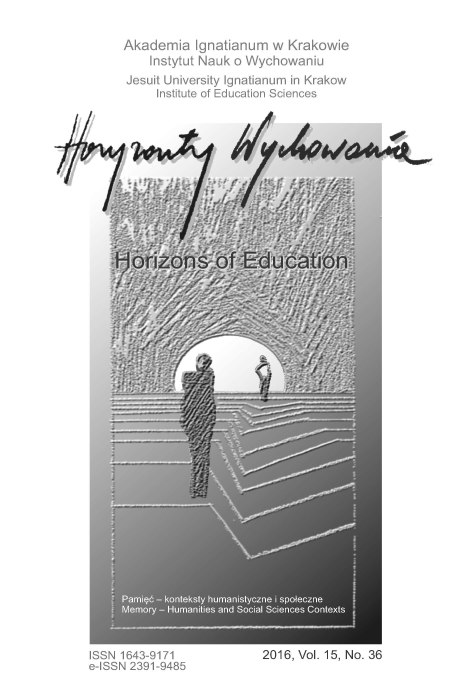Reprezentacje społeczne jako nośniki pamięci zbiorowej
Social Representations as the Collective Memory Medium
Author(s): Zuzanna Zbróg, Piotr ZbrógSubject(s): Social Sciences, Language and Literature Studies, Communication studies, Sociology, Theory of Communication
Published by: Uniwersytet Ignatianum w Krakowie
Keywords: pamięć zbiorowa; reprezentacje społeczne
Summary/Abstract: CEL NAUKOWY: Celem artykułu jest przedstawienie teoretycznych podstaw, nieznanej jeszcze szerzej w polskiej myśli humanistycznej i społecznej, koncepcji reprezentacji społecznych jako nośników pamięci zbiorowej. PROBLEM I METODY BADAWCZE: Przedstawiony problem badawczy dotyczy odpowiedzi na pytanie: jak można wykorzystać teorię reprezentacji społecznych do analiz rozumienia podstawowych pedagogicznych kategorii pojęciowych? Zastosowano analizę literatury przedmiotu oraz eksploracyjne metody badań wykorzystywane w ustalaniu rdzenia i elementów peryferii reprezentacji społecznych: wolnych skojarzeń werbalnych i ewokacji hierarchicznej. PROCES WYWODU: Po wstępnym zdefiniowaniu celu pracy oraz zasadniczych pojęć (pamięć, pamięć zbiorowa, reprezentacje społeczne) omówiono różne rodzaje modalności, poprzez które działa pamięć zbiorowa (ciało, język i organizacja przestrzeni) oraz na przykładzie analizy pojęcia „wychowanie” pokazano sposób ustalania struktury reprezentacji społecznych. WYNIKI ANALIZY NAUKOWEJ: Przykładowa analiza studenckich reprezentacji wychowania dowiodła, że omawiana teoria stanowić może adekwatną podstawę metodologiczną do ustalenia struktury reprezentacji społecznych podstawowych pojęć pedagogicznych. WNIOSKI, INNOWACJE, REKOMENDACJE: Teoria reprezentacji społecznych stwarza duże możliwości analizy i interpretacji danych w kontekstach kulturowych i historycznych. Studiowanie struktury reprezentacji umożliwia identyfikację dominujących reprezentacji wybranego obiektu społecznego, a badania longituidalne mogą pokazać jakościowe zmiany najpierw w elementach peryferyjnych, a następnie centralnych. Pozwala to na przemyślane planowanie modyfikacji reprezentacji społecznych w kierunku powszechnie oczekiwanym (np. w edukacji). RESEARCH OBJECTIVE: The aim of the article is to present the theoretical basis of the concept of social representations as collective memory medium with which the Polish humanities and social science is not yet familiar. THE RESEARCH PROBLEM AND METHODS: The presented research problem concerns the answer to the following question: how can the social representation theory be applied to analyse the understanding of the basic, pedagogical conceptual categories. The analysis of source literature was applied as well as exploratory research methods used in the establishment of the core and elements of periphery of social representations: free verbal associations and hierarchical evocation exploratory methods: free association and hierarchical evocation THE PROCESS OF ARGUMENTATION: After the aim of the article and basic terms (memory, collective memory, social representations) were initially defined, different types of modality through which the collective memory acts (body, language and space organization) were discussed. The analysis of the term ‘upbringing’ served as an example to present the way in which the structure of social representations is established. RESEARCH RESULTS: A sample analysis of students’ representations of upbringing has proven that the discussed theory may be an methodological foundation adequate for the establishment of the structure of social representations of the basic pedagogical terms. CONCLUSIONS, INNOVATIONS, RECOMMENDATIONS: The social representation theory creates possibilities for the analysis and interpretation of data in cultural and historical contexts. The studying of the structure of representations enables us to identify the dominant representations of a given social object and the longitudinal study may show the qualitative changes at first in the periphery elements and then in the central elements. This allows us to plan the modifications of social representations in the commonly expected direction (e.g. in education).
Journal: Horyzonty Wychowania
- Issue Year: 15/2016
- Issue No: 36
- Page Range: 11-27
- Page Count: 17
- Language: Polish

